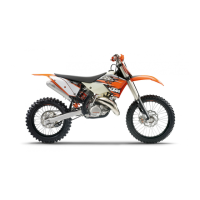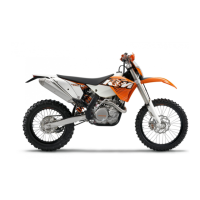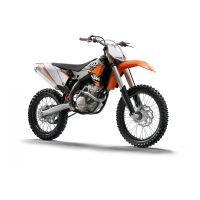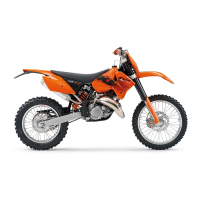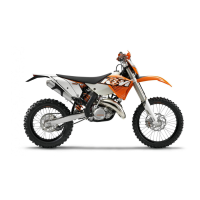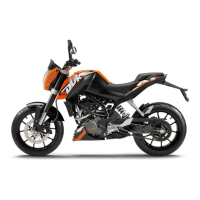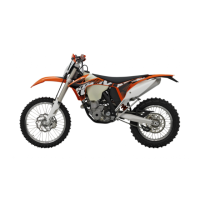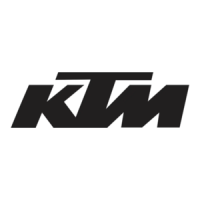
Do you have a question about the KTM 200 EXC EU 2010 and is the answer not in the manual?
| Bore x Stroke | 64.0 mm x 62.0 mm |
|---|---|
| Transmission | 6-speed |
| Fuel System | Keihin PWK 36 mm carburetor |
| Seat Height | 960 mm (37.8 in) |
| Fuel Tank Capacity | 8.5 L (2.25 gal) |
| Clutch | Wet multi-disc clutch, hydraulically operated |
| Front Suspension | WP USD 48 mm |
| Rear Suspension | WP PDS shock absorber |
| Front Brake | Disc brake, 260 mm |
| Rear Brake | Disc brake, 240 mm |
| Front Tire | 90/90-21 |
| Rear Tire | 140/80-18 |
| Dry Weight | 96 kg (211.6 lbs) |
| Compression Ratio | 12.5:1 |
| Starter | Kick starter |
| Engine Type | Single cylinder, 2-stroke |
| Engine | Single cylinder, 2-stroke |
| Ignition | Kokusan digital |
| Cooling | Liquid-cooled |
| Cooling System | Liquid Cooled |
| Frame | Chromium-Molybdenum steel central tube frame |
Explains symbols used in the manual for clarity.
Details typographical and other formats used throughout the manual.
Defines intended use for EXC/Six Days and XC-W/XC models.
Importance of maintenance and conditions for warranty claims.
Notes on transport, fire hazards, environmental impact, and risk grades.
Emphasizes reading and understanding the owner's manual for safe operation.
Identifies key components shown in the left front view of the motorcycle.
Identifies key components shown in the right rear view of the motorcycle.
Details on locating chassis, engine, fork, and shock absorber numbers.
Location of the vehicle's type label and key identification number.
Details on clutch, brake levers, throttle, switches, and buttons.
Operation and settings for speedometer and tripmaster functions.
Fuel tap, choke, shift lever, and kickstarter operation.
Operation of the steering lock mechanism for securing the vehicle.
Essential safety advice and initial checks before the first ride.
Guidelines for engine break-in and performance limits.
Specific preparations for various riding environments and temperatures.
Essential pre-ride checks for safety and proper vehicle function.
Procedures for starting the engine, changing gears, and effective braking.
Safe procedures for parking the motorcycle and refueling the fuel tank.
Maintenance tasks to be performed by an authorized KTM workshop.
Regular checks and maintenance tasks for the motorcycle owner.
Adjusting fork, shock absorber damping, preload, and sag.
Brake discs, fluid, linings, and lever adjustments.
Chain, wheels, tires, and spokes maintenance.
Battery, cooling, air filter, carburetor, and engine oil.
Diagnosing issues with the starter and engine start.
Troubleshooting no idle, poor acceleration, or stalling.
Addressing engine overheating and white smoke emissions.
Guidelines for cleaning the motorcycle safely and effectively.
Steps to take before storing the motorcycle for extended periods.
Procedures for putting a stored motorcycle back into operation.
Details on engine design, displacement, bore, stroke, and capacities.
Carburetor settings by altitude and temperature.
Frame, dimensions, weights, suspension travel, fork, and shock absorber data.
Specified torque values for engine and chassis components.
Electrical schematics for various motorcycle models.
List of electrical components and their corresponding cable colors.
